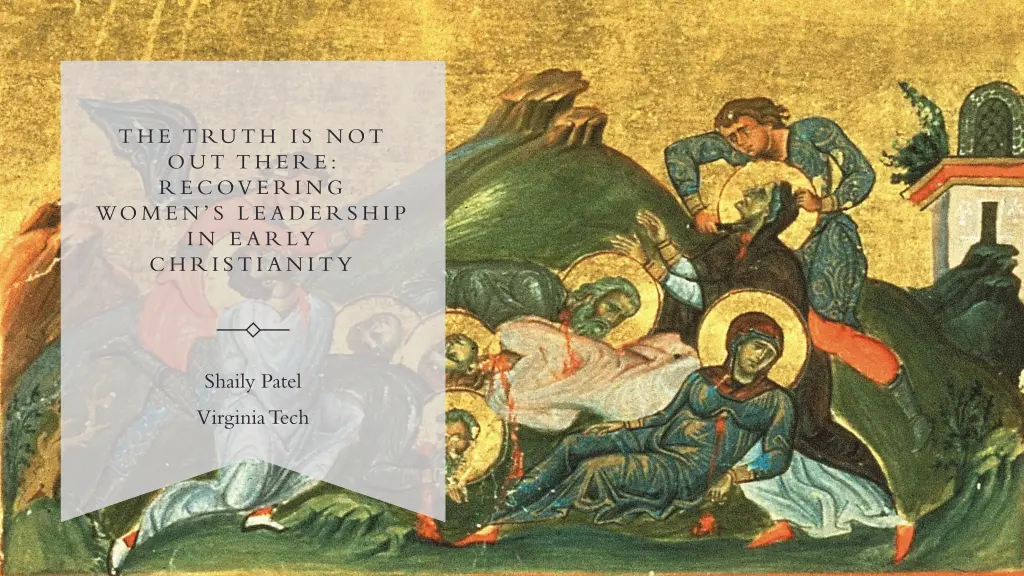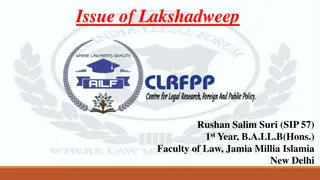
Recovering Women's Leadership in Early Christianity
Explore the historical evidence of women leaders in early Christianity, including stories around Jesus, women in the ministry of Jesus, and women mentioned in the Pauline corpus. Discover the diverse roles and contributions of women in the early Church.
Download Presentation

Please find below an Image/Link to download the presentation.
The content on the website is provided AS IS for your information and personal use only. It may not be sold, licensed, or shared on other websites without obtaining consent from the author. If you encounter any issues during the download, it is possible that the publisher has removed the file from their server.
You are allowed to download the files provided on this website for personal or commercial use, subject to the condition that they are used lawfully. All files are the property of their respective owners.
The content on the website is provided AS IS for your information and personal use only. It may not be sold, licensed, or shared on other websites without obtaining consent from the author.
E N D
Presentation Transcript
THE TRUTH IS NOT OUT THERE: RECOVERING WOMEN S LEADERSHIP IN EARLY CHRISTIANITY Shaily Patel Virginia Tech
HISTORIOGRAPHY AND THEOLOGY W H AT T RU T H D O W E S E E K I N T H E PA S T ? In our case, what s the truth about whether or not women held leadership positions in the early Church?
Women Leaders in Early Christianities: Lots of Evidence! Stories around Jesus (Mary, Mary, Mary and Martha...Everyone is named Mary, really.) Co-workers with Paul (Junia, the Apostle) Women martyrs (Perpetua, Felicity, Thecla, etc.) Women prophets in groups like Montanism. The feminine divine in gnostic and other texts. Women maligned and silenced by Church Fathers. Monastic women. Material evidence like the recently-discovered Ashdod mosaics.
Women in the Ministry of Jesus Mary, the mother of Jesus. Mary is mentioned in all the gospels. In Luke s narrative in particular, we are told about how Mary herself was blessed by God and chosen to give birth to Jesus. In fact, Jesus coming was prophesied by a woman named Anna in Luke (Luke 2:36-38). Woman who anoints Jesus. One who lived a sinful life in Luke and Mary of Bethany in John. A woman in Mark and Matthew (Mark 14:3-9; Matthew 26:6-13; Luke 7:36-50; John 12:1- 8). Samaritan woman at the well in John (John 4:4-26). She clearly represents Jesus message as being available to those who aren t Jews. Mary and Martha (Luke 10:38-42). Depicts Jesus visiting the home of women and teaching them.
Women Mentioned in the Pauline Corpus Phoebe, who Paul calls a deacon. Phoebe is mentioned in Romans 16:1-2. It seems like she s one of the leaders of Church at Cenchreae. She seems to be a patron of Paul and she s being entrusted to carry his letter to Rome. Prisca is mentioned alongside her husband Aquila (Romans 16:3-4). They seem to be working towards Gentile conversion. Mary is a colleague who works in the Roman church (Romans 16:6). Paul also mentions the names of Tryphanaea, Tryphosa, and Persis who are all coworkers (Romans 16:6). And then there s a woman named Junia, a woman referred to as foremost among the apostles (Romans 16:7).
Women Leaders in Early Christianities: Lots of Evidence! Stories around Jesus (Mary, Mary, Mary and Martha...Everyone is named Mary, really.) Co-workers with Paul (Junia, the Apostle) Women martyrs (Perpetua, Felicity, Thecla, etc.) Women prophets in groups like Montanism. The feminine divine in gnostic and other texts. Women maligned and silenced by Church Fathers. Monastic women. Material evidence like the recently-discovered Ashdod mosaics.
WHAT DO WE REALLY GET FROM THE PAST? A Case Study in Confusion: 1 Cor. 14:34-35
31For you can all prophesy one by one, so that all may learn and all be encouraged.32And the spirits of prophets are subject to the prophets,33for God is a God not of disorder but of peace. As in all the churches of the saints,34women should be silent in the churches. For they are not permitted to speak, but should be subordinate, as the law also says.35If there is anything they desire to know, let them ask their husbands at home. For it is shameful for a woman to speak in church.36Or did the word of God originate with you? Or are you the only ones it has reached?] 37Anyone who claims to be a prophet, or to have spiritual powers, must acknowledge that what I am writing to you is a command of the Lord.38Anyone who does not recognize this is not to be recognized. THE TROUBLE WITH PAUL I C O R . 1 4 : 3 1 - 3 8
HISTORY NEVER YIELDS TRUTH; IT ONLY YIELDS EVIDENCE and that evidence is contested by many people for many ends.
Some Rationales for drafting the Statement: The widespread uncertainty and confusion in our culture regarding the complementary differences between masculinity and femininity THE The increasing promotion given to feminist egalitarianism DANVERS STATEMENT, 1988 the emergence of roles for men and women in church leadership that do not conform to Biblical teaching the increasing prevalence and acceptance of hermeneutical oddities devised to reinterpret apparently plain meanings of Biblical texts Full text available: https://cbmw.org/about/danvers- statement/
The Statement Affirms the Following: The Fall introduced distortions into the relationships between men and women (Gen 3:1-7,12,16). In the home, the husband s loving, humble headship tends to be replaced by domination or passivity; the wife s intelligent, willing submission tends to be replaced by usurpation or servility. In the church, sin inclines men toward a worldly love of power or an abdication of spiritual responsibility, and inclines women to resist limitations on their roles or to neglect the use of their gifts in appropriate ministries. THE DANVERS STATEMENT, 1988 Redemption in Christ aims at removing the distortions introduced by the curse. In the family, husbands should forsake harsh or selfish leadership and grow in love and care for their wives; wives should forsake resistance to their husbands authority and grow in willing, joyful submission to their husbands leadership (Eph 5:21-33;Col 3:18-19;Tit 2:3-5;1 Pet 3:1-7). In the church, redemption in Christ gives men and women an equal share in the blessings of salvation; nevertheless, some governing and teaching roles within the church are restricted to men (Gal 3:28;1 Cor 11:2-16;1 Tim 2:11-15). Full text available: https://cbmw.org/about/danvers-statement/
SO IF THERES NO TRUTH IN THE PAST, WHAT IS THERE? Conflicting but vibrant evidence for women s leadership in early Christianities.
Case Study I: Martyrdom of Perpetua and Felicity, ~200 CE Inversion of traditional Roman gender roles: Perpetua is depicted in several passages as masculine. At her trial, she does not back down despite being pressured by two men who have legal authority over her. She gives up her role as mother, thereby refusing one of Rome s most important roles for women. She demonstrates the characteristics of a virtuous Roman man: stoicism, reason, and determination in the face of death. The payoff: The Martyrdom of Perpetua and Felicity basically tells Romans that Christian women better embody Roman masculine virtues than Roman men! A far cry from the Danvers Statement.
Case Study 2: Montanism and Women Prophets Oracles Attributed to Maximilla Oracles Attributed to Priscilla And let not the spirit which speak through Maximilla say I am pursued like a wolf from the sheep. I am not a wolf. I am word, and spirit, and power. The Holy Spirit has also said well of them through the prophetess Priscilla: They are flesh, and they hate the flesh. Likewise the holy prophetess Priscilla preaches that they holy minister should know how to administer purity of life. For purification produces harmony, she says, and they see visions, and when they turn their faces downward they also hear salutary voices, as clear as they are secret. For the one they call Maximilla, the prophetess, declares: After me, there will no longer be a prophet, but the end. For hear, O Children of Christ, What Maximilla says: Hear not me, but hear Christ.
Case Study 3: Egerias Pilgrimage Diary, ~380 CE Writing to her dear ladies so they might see through her eyes. Bishops love her! Evidence concerning the worship of Saint Thecla. Thecla was particularly venerated by women, suggesting that women carried on their own styles of worship despite what Church Fathers may have instructed. Egeria s encounter with the deaconess Marthana.
CONCLUSION: HISTORY, ETHICS, AND CHOICE






















